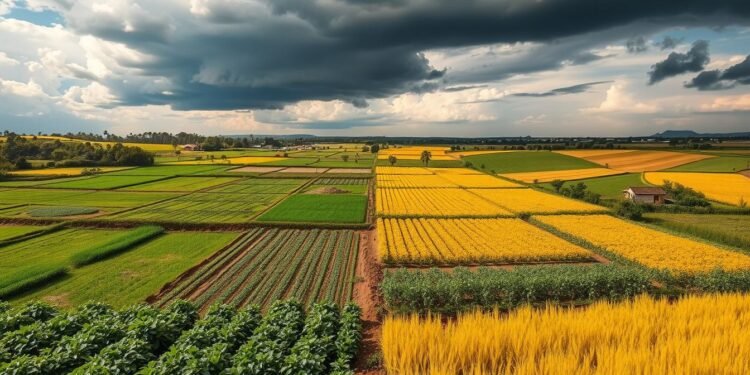Sustainable agriculture is trying to feed more people while saving our planet. It faces many challenges, from environmental issues to economic ones. Farmers are working hard to make farming sustainable.
The U.S. Department of Agriculture says we need to use oil and natural gas wisely. This shows the fine line sustainable farming must walk between growing food and saving resources.
For small farmers, making money is a big worry. The World Wildlife Fund says farming helps many poor people worldwide. This shows how important sustainable farming is globally.
Social issues are also important. The University of California Davis talks about animal care and farming methods in sustainable systems. These things affect how much food we get and how people feel about farming.
Let’s look at how environmental, economic, and social challenges mix together. They shape the future of farming in complex ways.
Key Takeaways
- Sustainable agriculture aims to meet current food needs without compromising future generations
- Environmental challenges include resource management and conservation
- Economic viability is key, mainly for small-scale farmers
- Social issues cover animal welfare and community acceptance
- Balancing productivity with sustainability is a major challenge
- Global poverty reduction is linked to sustainable agricultural practices
Overview of Sustainable Agriculture
Sustainable agriculture is a way to farm that cares for the environment and people. It aims to meet today’s needs without harming tomorrow’s. This method uses techniques that keep soil healthy, save water, and protect wildlife.
Definition and Principles
Agricultural sustainability combines environmental care, economic gain, and fairness for all. It uses resources wisely, looks after animals, and balances everyone’s needs. Sustainable farms manage land well, stop erosion, and support many species.
They use different crops, avoid tillage, and manage pests to improve soil. This reduces the need for harmful chemicals.
Importance of Sustainability in Agriculture
Sustainable agriculture is vital. It fights poverty, boosts wealth, and ensures food for more people. It keeps natural resources safe, improves water use, and makes crops healthier.
By focusing on soil and wildlife, it builds strong food systems. These systems can face environmental and climate challenges.
Sustainable farming also brings economic benefits. It offers jobs and security for farmers, workers, and buyers. As more people support it, it’s clear sustainable farming is essential for a better future.
Environmental Challenges
Sustainable agriculture faces big environmental challenges. These affect soil health, water, and biodiversity. It’s key for food security and ecological balance.
Soil Degradation and Erosion
Soil conservation is a big issue in farming. Over one-third of the world’s topsoil has been lost. This is due to land conversion and old farming ways.
Sustainable methods like integrated nutrient management can improve soil health. This helps keep soil productive.
Water Scarcity Issues
Agriculture uses 70% of global freshwater, putting a strain on resources. Good water management is vital for farming. In sub-Saharan Africa, old practices are common, with few using new tech like drip irrigation.
Using water-efficient methods can cut down water use in farming.
Loss of Biodiversity
Keeping ecosystems healthy is key. The loss of rice varieties in India and wild foods in Gambia shows the problem. Sustainable farming works to keep crop diversity and protect wildlife.
This helps with natural pest control and pollination. These are vital for farming to be sustainable.
Economic Challenges
Sustainable agriculture faces big economic hurdles. Farmers face high costs when they start using eco-friendly methods. These costs can be tough for small farms to handle.
Even though these methods are good in the long run, the initial cost stops many farmers. They don’t want to spend a lot of money at first.
Market Access and Pricing
Getting into the market is hard for sustainable farmers. They can’t compete with cheaper, conventional products because of their higher costs. This makes it hard for them to sell their products.
Prices for sustainable goods are hard to find. People might not want to pay more for these products. This makes it tough for farmers to make a profit.
Small Farmer Struggles
Small farmers have big economic worries. They don’t have enough money to deal with market changes or new technology. Big farms get help from global subsidies, making it harder for small ones.
This unfair advantage hurts the variety of our food. It’s a big problem for our farms.
To solve these problems, we need new ways to fund farming and change policies. We should help small farmers get into the market and support them. This way, we can make farming better for everyone.
Social Challenges
Sustainable agriculture meets big social hurdles. These issues affect farmers, communities, and the whole farming world. It’s key to understand these problems to find good solutions.
Community Resistance to Change
Farmers might not want to try new, sustainable ways because of what others think. The fear of being judged holds them back. This makes it hard to move towards better farming methods.
This resistance comes from old traditions and fear of the new. It’s a big obstacle in the journey to sustainable farming.
Knowledge and Skill Gaps
To use sustainable farming, farmers need new skills and knowledge. But many don’t get the training they need. Programs that help farmers learn are very important.
Without the right skills, farmers find it tough to keep up with sustainable farming. This makes it hard for them to succeed.
Equity and Access Issues
Equity in farming is a big problem. Many people, mostly in farming, live in extreme poverty. They face big challenges getting the resources, money, and markets they need.
Small farmers have it even harder because they can’t compete with big farms. Fixing these fairness issues is key for sustainable farming to work.
The Global Agribusiness Action on Equitable Livelihoods (GAA-EL) project is working on these issues. It wants to help farmers get better market access, protect their rights, and support inclusive innovation. GAA-EL works with many groups to make farming fairer for everyone.
Technological Challenges
Farming technology has made great strides, but many farms struggle. In 2023, only 27% of U.S. farms used precision agriculture. This shows a big gap between available tools and their use.
Requirement for Innovation
We need new ways to feed a growing world. With just 12% of land good for farming, innovation is essential. The USDA and NSF have put nearly $200 million into precision agriculture research from 2017 to 2021. Their goal is to boost crop yields and reduce resource use.
Integration of Technology in Traditional Farming
Combining new tech with old farming methods is hard. Farmers face high costs and a steep learning curve. But, the benefits are worth it. Precision farming can increase profits by improving yields or using fewer inputs.
This is important because farming uses 70% of the world’s fresh water and causes 23% of greenhouse gas emissions.
Data Management and Analysis
Data-driven agriculture is the future of farming. It helps track soil health, water use, and crop growth. But, managing this data is a challenge for many farmers.
They need training and support to use these tools effectively. As 180,000 people leave rural areas for cities each day, smart farming could help keep farms productive and profitable.
Policy and Regulatory Challenges
The journey to sustainable agriculture is full of obstacles in policy and regulation. Farmers struggle with a lack of support for sustainable farming. This is because policies often favor traditional farming over green practices.
Lack of Supportive Policies
Today’s agricultural policies mainly support old farming ways. For example, 75% of subsidies go to commodity crops. This leaves sustainable farmers behind, making it hard for them to switch to better methods.
Regulatory Hurdles Facing Farmers
The federal crop insurance program actually pushes farmers to take risks. It’s easier to insure crops on poor land than the cover crops used in sustainable farming. This makes it tough for farmers to choose greener options.
Need for Incentives
To encourage sustainable farming, we need more incentives. Farmers could get tax breaks for using soil conservation or grants for going organic. These would help cover the costs of sustainable farming and make it more appealing to farmers.
Climate Change Impacts
Climate change is a big problem for farming. Farmers now deal with more extreme weather than ever. This includes big floods, long droughts, and hot heatwaves. They need to act fast to adapt to these changes.
Extreme Weather Events
Extreme weather has a huge impact on farming. Rural areas are very vulnerable because they have less resources and infrastructure. These events can destroy crops, causing food shortages and economic losses. Farmers must find ways to protect their crops.
Shifts in Growing Seasons
Climate change is changing when crops can grow. This change affects when farmers can plant and harvest. It can also lower crop yields. Farmers must adjust their plans and choose the right crops for the new climate.
Crop Resilience
It’s important to make crops more resilient. Using cover crops helps the soil and keeps water in. Diverse farming systems and traditional farming methods can also help. These methods not only help crops but also fight climate change.
Health and Safety Challenges
Sustainable farming faces big challenges in keeping food safe and protecting farmers. The use of pesticides and chemicals in farming is risky for both consumers and workers. It’s important to control pesticides well to lessen these dangers.
Pesticide and Chemical Use
Pesticides help fight pests but can harm people’s health. Every year, up to 300,000 deaths worldwide are linked to pesticide poisoning. Between 500,000 and 1 million people face health issues from these chemicals each year.
In India, about 40% of farmland is treated with pesticides. This raises big concerns about exposure risks.
Food Safety Concerns
Food safety is a big worry in farming. In some countries, yearly food calorie consumption is dropping by 0.8% to 2.2%. This shows we need safer farming practices.
In China, 19.4% of farmland has heavy metal levels above safe limits. This could affect food quality.
Impacts on Farmer Health
Farming is hard on worker health. In 2017, crop workers reported 5.2 injuries per 100 workers. The job can be deadly, with 20.9 deaths per 100,000 workers.
Health issues like back pain affect 52% of farmers in India. Respiratory problems are common, with a 3.59% prevalence among Indian agricultural workers. Improving farmer health is key to sustainable agriculture’s success.
Educational and Awareness Challenges
Sustainable agriculture faces big challenges in education and awareness. Farmers need better access to knowledge and skills for eco-friendly practices. This shows the need for strong agricultural education programs.
Need for Training Programs
Farmers often don’t know how to use sustainable techniques. Training programs can help by teaching methods like precision agriculture and integrated pest management. These skills lower farming’s ecological impact and increase productivity.
Importance of Public Awareness
Public awareness is key for sustainable agriculture. When people know the benefits of sustainable food, they support it more. This demand can lead to policy changes and more farmers using sustainable practices.
Role of Agricultural Institutions
Agricultural institutions are important for sustainable farming. They do research, educate, and share new techniques. But, they face challenges like old curricula and limited funding. Overcoming these is essential for supporting farmers well.
Fixing these educational and awareness issues is vital for sustainable agriculture. By improving education, raising awareness, and strengthening support, we can build a sustainable food system for the future.
Future Directions and Solutions
The journey to sustainable agriculture is filled with new ideas and community efforts. We need to feed 9 billion people by 2050, and sustainable farming is key. It aims to protect our planet and increase food by 70%.
Innovations in Sustainable Practices
New technologies are changing farming. Artificial Intelligence, drones, and blockchain are leading the way. They help farmers use fewer chemicals and keep soil healthy.
For instance, the University of Edinburgh has made a big discovery. They’ve created a non-GMO cell line for livestock. This could change the meat industry, making it more sustainable and scalable.
Community-Based Approaches
Community farming is vital for sustainable agriculture. Local projects help spread new ideas and overcome obstacles. The Global Challenge campaign is a great example.
It brought together 126 projects from 65 institutes with biotech companies. This led to over 230 new partnerships. Community efforts are essential for adopting sustainable farming on a large scale.
Policy Changes for Better Support
Policy reform is critical for sustainable farming’s success. Groups like the World Bank and the American Farm Bureau Federation are advocating for change. They want policies that help farmers switch to sustainable methods.
Changing subsidy systems to support regenerative farming is also important. With the right policies, we can reduce global greenhouse gas emissions from food production by 34%.
FAQ
What is sustainable agriculture?
Sustainable agriculture is a way to farm that meets our food needs today and tomorrow. It’s about taking small steps to care for the earth and our farms. This approach is influenced by our family’s needs and goals.
Why is sustainable agriculture important?
It’s key because it can fight poverty, increase wealth, and feed more people. It also protects our natural resources and improves animal welfare. It helps balance different needs and goals.
What are the main environmental challenges in sustainable agriculture?
Big challenges include soil loss, water scarcity, and biodiversity loss. Over a third of the world’s topsoil has been lost, and 70% of freshwater is used for farming.
What economic challenges do farmers face in adopting sustainable practices?
High costs and market access issues are big hurdles. Sustainable farming can be expensive upfront but can pay off in the long run. Small farmers face extra challenges.
How does climate change impact sustainable agriculture?
Climate change brings extreme weather, changing seasons, and the need for resilient crops. Maize yields could drop by 24% in 60 years. We must adopt practices that help.
What role does technology play in sustainable agriculture?
Technology is vital, with tools like drip irrigation and IoT tractors. Data tools help monitor soil and water. But, cost and expertise are barriers to adoption.
How can policy changes support sustainable agriculture?
Changes in policy can help by supporting sustainable farming. This includes better subsidies and loans for sustainable methods. Current policies often favor conventional farming.
What are some health and safety challenges in sustainable agriculture?
Challenges include reducing pesticide use and ensuring food safety. Sustainable farming aims to protect both the environment and human health.
How can education and awareness help overcome challenges in sustainable agriculture?
Education and awareness are key. They provide training for farmers and raise public demand for sustainable food. Agricultural institutions play a big role in teaching sustainable farming.
What are some innovative solutions for the future of sustainable agriculture?
Solutions include vertical farming and community-based approaches. Policy changes and agroforestry are also promising. Organic farming is another way forward.





